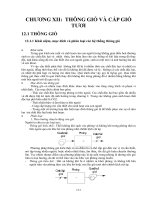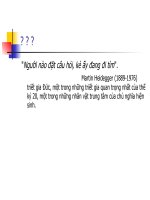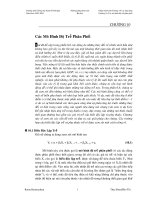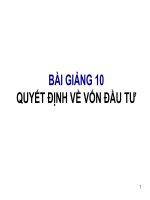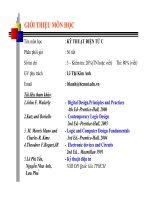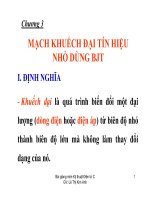C#: Chương 10
Bạn đang xem bản rút gọn của tài liệu. Xem và tải ngay bản đầy đủ của tài liệu tại đây (419.47 KB, 80 trang )
2002 Prentice Hall. All rights reserved.
1
Chapter 10 – Object-Oriented
Programming: Polymorphism
Outline
10.1 Introduction
10.2 Derived-Class-Object to Base-Class-Object Conversion
10.3 Type Fields and switch Statements
10.4 Polymorphism Examples
10.5 Abstract Classes and Methods
10.6 Case Study: Inheriting Interface and Implementation
10.7 sealed Classes and Methods
10.8 Case Study: Payroll System Using Polymorphism
10.9 Case Study: Creating and Using Interfaces
10.10 Delegates
10.11 Operator Overloading
2002 Prentice Hall. All rights reserved.
2
10.1 Introduction
•
Polymorphism allows programmers to write:
–
Programs that handle a wide variety of related classes in a
generic manner
–
Systems that are easily extensible
2002 Prentice Hall. All rights reserved.
3
10.2 Derived-Class-Object to Base-Class-
Object Conversion
•
Class hierarchies
–
Can assign derived-class objects to base-class references
–
Can explicitly cast between types in a class hierarchy
•
An object of a derived-class can be treated as an
object of its base-class
–
Array of base-class references that refer to objects of many
derived-class types
–
Base-class object is NOT an object of any of its derived
classes
2002 Prentice Hall.
All rights reserved.
Outline
4
Point.cs
1 // Fig. 10.1: Point.cs
2 // Point class represents an x-y coordinate pair.
3
4 using System;
5
6 // Point class definition implicitly inherits from Object
7 public class Point
8 {
9 // point coordinate
10 private int x, y;
11
12 // default constructor
13 public Point()
14 {
15 // implicit call to Object constructor occurs here
16 }
17
18 // constructor
19 public Point( int xValue, int yValue )
20 {
21 // implicit call to Object constructor occurs here
22 X = xValue;
23 Y = yValue;
24 }
25
26 // property X
27 public int X
28 {
29 get
30 {
31 return x;
32 }
33
Definition of class Point
2002 Prentice Hall.
All rights reserved.
Outline
5
Point.cs
34 set
35 {
36 x = value; // no need for validation
37 }
38
39 } // end property X
40
41 // property Y
42 public int Y
43 {
44 get
45 {
46 return y;
47 }
48
49 set
50 {
51 y = value; // no need for validation
52 }
53
54 } // end property Y
55
56 // return string representation of Point
57 public override string ToString()
58 {
59 return "[" + X + ", " + Y + "]";
60 }
61
62 } // end class Point
2002 Prentice Hall.
All rights reserved.
Outline
6
Circle.cs
1 // Fig. 10.2: Circle.cs
2 // Circle class that inherits from class Point.
3
4 using System;
5
6 // Circle class definition inherits from Point
7 public class Circle : Point
8 {
9 private double radius; // circle's radius
10
11 // default constructor
12 public Circle()
13 {
14 // implicit call to Point constructor occurs here
15 }
16
17 // constructor
18 public Circle( int xValue, int yValue, double radiusValue )
19 : base( xValue, yValue )
20 {
21 Radius = radiusValue;
22 }
23
24 // property Radius
25 public double Radius
26 {
27 get
28 {
29 return radius;
30 }
31
Definition of class Circle which
inherits from class Point
2002 Prentice Hall.
All rights reserved.
Outline
7
Circle.cs
32 set
33 {
34 if ( value >= 0 ) // validate radius
35 radius = value;
36 }
37
38 } // end property Radius
39
40 // calculate Circle diameter
41 public double Diameter()
42 {
43 return Radius * 2;
44 }
45
46 // calculate Circle circumference
47 public double Circumference()
48 {
49 return Math.PI * Diameter();
50 }
51
52 // calculate Circle area
53 public virtual double Area()
54 {
55 return Math.PI * Math.Pow( Radius, 2 );
56 }
57
58 // return string representation of Circle
59 public override string ToString()
60 {
61 return "Center = " + base.ToString() +
62 "; Radius = " + Radius;
63 }
64
65 } // end class Circle
2002 Prentice Hall.
All rights reserved.
Outline
8
PointCircleTest.
cs
1 // Fig. 10.3: PointCircleTest.cs
2 // Demonstrating inheritance and polymorphism.
3
4 using System;
5 using System.Windows.Forms;
6
7 // PointCircleTest class definition
8 class PointCircleTest
9 {
10 // main entry point for application.
11 static void Main( string[] args )
12 {
13 Point point1 = new Point( 30, 50 );
14 Circle circle1 = new Circle( 120, 89, 2.7 );
15
16 string output = "Point point1: " + point1.ToString() +
17 "\nCircle circle1: " + circle1.ToString();
18
19 // use 'is a' relationship to assign
20 // Circle circle1 to Point reference
21 Point point2 = circle1;
22
23 output += "\n\nCCircle circle1 (via point2): " +
24 point2.ToString();
25
26 // downcast (cast base-class reference to derived-class
27 // data type) point2 to Circle circle2
28 Circle circle2 = ( Circle ) point2;
29
30 output += "\n\nCircle circle1 (via circle2): " +
31 circle2.ToString();
32
33 output += "\nArea of circle1 (via circle2): " +
34 circle2.Area().ToString( "F" );
35
Create a Point object
Create a Circle object
Assign a Point reference to
reference a Circle object
Assign a Circle reference to
reference a Point object
(downcast)
Use base-class reference to
access a derived-class object
Use derived-class
reference to access a
base-class object
2002 Prentice Hall.
All rights reserved.
Outline
9
PointCircleTest.
cs
Program Output
36 // attempt to assign point1 object to Circle reference
37 if ( point1 is Circle )
38 {
39 circle2 = ( Circle ) point1;
40 output += "\n\ncast successful";
41 }
42 else
43 {
44 output += "\n\npoint1 does not refer to a Circle";
45 }
46
47 MessageBox.Show( output,
48 "Demonstrating the 'is a' relationship" );
49
50 } // end method Main
51
52 } // end class PointCircleTest
Test if point1 references a Circle
object – it cannot, because of the
downcasting on line 28
2002 Prentice Hall. All rights reserved.
10
10.3 Type Fields and switch Statements
•
Using switch to determine the type of an object
–
Distinguish between object, perform appropriate action
depending on object type
•
Potential problems using switch
–
Programmer may forget to include a type test
–
Programmer may forget to test all possible cases
–
When new types are added, programmer may forget to modify
all relevant switch structures
–
Every addition or deletion of a class requires modification of
every switch statement in the system; tracking this is time
consuming and error prone
2002 Prentice Hall. All rights reserved.
11
10.4 Polymorphism Examples
•
Quadrilateral base-class
–
Rectangle derived-class
–
Square derived-class
–
Parallelogram derived-class
–
Trapezoid derived-class
–
Method perimeter might need to be invoked on all classes
–
With a Quadrilateral reference, C# polymorphically chooses
the correct overriding method in the derived-class from which
the object is instantiated
2002 Prentice Hall. All rights reserved.
12
10.4 Polymorphism Examples
•
SpaceObject base-class – contains method DrawYourself
–
Martian derived-class (implements DrawYourself)
–
Venutian derived-class (implements DrawYourself)
–
Plutonian derived-class (implements DrawYourself)
–
SpaceShip derived-class (implements DrawYourself)
•
A screen-manager program may contain a SpaceObject
array of references to objects of various classes that derive
from SpaceObject
•
To refresh the screen, the screen-manager calls
DrawYourself on each object in the array
•
The program polymorphically calls the appropriate version
of DrawYourself on each object, based on the type of that
object
2002 Prentice Hall. All rights reserved.
13
10.5 Abstract Classes and Methods
•
Abstract classes
–
Cannot be instantiated
–
Used as base classes
–
Class definitions are not complete – derived classes must
define the missing pieces
–
Can contain abstract methods and/or abstract properties
•
Have no implementation
•
Derived classes must override inherited abstract methods and
properties to enable instantiation
2002 Prentice Hall. All rights reserved.
14
10.5 Abstract Classes and Methods
•
Abstract classes are used to provide appropriate
base classes from which other classes may inherit
(concrete classes)
•
Abstract base classes are too generic to define real
objects
•
To define an abstract class, use keyword abstract
in the declaration
•
To declare a method or property abstract, use
keyword abstract in the declaration; abstract
methods and properties have no implementation
2002 Prentice Hall. All rights reserved.
15
10.5 Abstract Classes and Methods
•
Concrete classes use the keyword override to
provide implementations for all the abstract
methods and properties of the base-class
•
Any class with an abstract method or property must
be declared abstract
•
Even though abstract classes cannot be instantiated,
we can use abstract class references to refer to
instances of any concrete class derived from the
abstract class
2002 Prentice Hall. All rights reserved.
16
10.6 Case Study: Inheriting Interface and
Implementation
•
Abstract base class Shape
–
Concrete virtual method Area (default return value is 0)
–
Concrete virtual method Volume (default return value is 0)
–
Abstract read-only property Name
•
Class Point2 inherits from Shape
–
Overrides property Name (required)
–
Does NOT override methods Area and Volume
•
Class Circle2 inherits from Point2
–
Overrides property Name
–
Overrides method Area, but not Volume
•
Class Cylinder2 inherits from Circle2
–
Overrides property Name
–
Overrides methods Area and Volume
2002 Prentice Hall.
All rights reserved.
Outline
17
Shape.cs
1 // Fig. 10.4: Shape.cs
2 // Demonstrate a shape hierarchy using an abstract base class.
3 using System;
4
5 public abstract class Shape
6 {
7 // return Shape's area
8 public virtual double Area()
9 {
10 return 0;
11 }
12
13 // return Shape's volume
14 public virtual double Volume()
15 {
16 return 0;
17 }
18
19 // return Shape's name
20 public abstract string Name
21 {
22 get;
23 }
24 }
Declaration of abstract class Shape
Declaration of virtual methods
Area and Volume with default
implementations
Declaration of read-only abstract property
Name; implementing classes will have to
provide an implementation for this property
2002 Prentice Hall.
All rights reserved.
Outline
18
Point2.cs
1 // Fig. 10.5: Point2.cs
2 // Point2 inherits from abstract class Shape and represents
3 // an x-y coordinate pair.
4 using System;
5
6 // Point2 inherits from abstract class Shape
7 public class Point2 : Shape
8 {
9 private int x, y; // Point2 coordinates
10
11 // default constructor
12 public Point2()
13 {
14 // implicit call to Object constructor occurs here
15 }
16
17 // constructor
18 public Point2( int xValue, int yValue )
19 {
20 X = xValue;
21 Y = yValue;
22 }
23
24 // property X
25 public int X
26 {
27 get
28 {
29 return x;
30 }
31
32 set
33 {
34 x = value; // no validation needed
35 }
Class Point2 inherits from class Shape
2002 Prentice Hall.
All rights reserved.
Outline
19
Point2.cs
36 }
37
38 // property Y
39 public int Y
40 {
41 get
42 {
43 return y;
44 }
45
46 set
47 {
48 y = value; // no validation needed
49 }
50 }
51
52 // return string representation of Point2 object
53 public override string ToString()
54 {
55 return "[" + X + ", " + Y + "]";
56 }
57
58 // implement abstract property Name of class Shape
59 public override string Name
60 {
61 get
62 {
63 return "Point2";
64 }
65 }
66
67 } // end class Point2
Point2’s implementation of the
read-only Name property
2002 Prentice Hall.
All rights reserved.
Outline
20
Circle2.cs
1 // Fig. 10.6: Circle2.cs
2 // Circle2 inherits from class Point2 and overrides key members.
3 using System;
4
5 // Circle2 inherits from class Point2
6 public class Circle2 : Point2
7 {
8 private double radius; // Circle2 radius
9
10 // default constructor
11 public Circle2()
12 {
13 // implicit call to Point2 constructor occurs here
14 }
15
16 // constructor
17 public Circle2( int xValue, int yValue, double radiusValue )
18 : base( xValue, yValue )
19 {
20 Radius = radiusValue;
21 }
22
23 // property Radius
24 public double Radius
25 {
26 get
27 {
28 return radius;
29 }
30
Definition of class Circle2 which
inherits from class Point2
2002 Prentice Hall.
All rights reserved.
Outline
21
Circle2.cs
31 set
32 {
33 // ensure non-negative radius value
34 if ( value >= 0 )
35 radius = value;
36 }
37 }
38
39 // calculate Circle2 diameter
40 public double Diameter()
41 {
42 return Radius * 2;
43 }
44
45 // calculate Circle2 circumference
46 public double Circumference()
47 {
48 return Math.PI * Diameter();
49 }
50
51 // calculate Circle2 area
52 public override double Area()
53 {
54 return Math.PI * Math.Pow( Radius, 2 );
55 }
56
57 // return string representation of Circle2 object
58 public override string ToString()
59 {
60 return "Center = " + base.ToString() +
61 "; Radius = " + Radius;
62 }
Override the Area method
(defined in class Shape)
2002 Prentice Hall.
All rights reserved.
Outline
22
Circle2.cs
63
64 // override property Name from class Point2
65 public override string Name
66 {
67 get
68 {
69 return "Circle2";
70 }
71 }
72
73 } // end class Circle2
Override the read-only Name property
2002 Prentice Hall.
All rights reserved.
Outline
23
Cylinder2.cs
1 // Fig. 10.7: Cylinder2.cs
2 // Cylinder2 inherits from class Circle2 and overrides key members.
3 using System;
4
5 // Cylinder2 inherits from class Circle2
6 public class Cylinder2 : Circle2
7 {
8 private double height; // Cylinder2 height
9
10 // default constructor
11 public Cylinder2()
12 {
13 // implicit call to Circle2 constructor occurs here
14 }
15
16 // constructor
17 public Cylinder2( int xValue, int yValue, double radiusValue,
18 double heightValue ) : base( xValue, yValue, radiusValue )
19 {
20 Height = heightValue;
21 }
22
23 // property Height
24 public double Height
25 {
26 get
27 {
28 return height;
29 }
30
31 set
32 {
33 // ensure non-negative height value
34 if ( value >= 0 )
35 height = value;
Class Cylinder2
derives from Circle2
2002 Prentice Hall.
All rights reserved.
Outline
24
Cylinder2.cs
36 }
37 }
38
39 // calculate Cylinder2 area
40 public override double Area()
41 {
42 return 2 * base.Area() + base.Circumference() * Height;
43 }
44
45 // calculate Cylinder2 volume
46 public override double Volume()
47 {
48 return base.Area() * Height;
49 }
50
51 // return string representation of Circle2 object
52 public override string ToString()
53 {
54 return base.ToString() + "; Height = " + Height;
55 }
56
57 // override property Name from class Circle2
58 public override string Name
59 {
60 get
61 {
62 return "Cylinder2";
63 }
64 }
65
66 } // end class Cylinder2
Override Area implementation of class Circle2
Override read-only property Name
Override Volume implementation of class Shape
2002 Prentice Hall.
All rights reserved.
Outline
25
AbstractShapesTe
st.cs
1 // Fig. 10.8: AbstractShapesTest.cs
2 // Demonstrates polymorphism in Point-Circle-Cylinder hierarchy.
3 using System;
4 using System.Windows.Forms;
5
6 public class AbstractShapesTest
7 {
8 public static void Main( string[] args )
9 {
10 // instantiate Point2, Circle2 and Cylinder2 objects
11 Point2 point = new Point2( 7, 11 );
12 Circle2 circle = new Circle2( 22, 8, 3.5 );
13 Cylinder2 cylinder = new Cylinder2( 10, 10, 3.3, 10 );
14
15 // create empty array of Shape base-class references
16 Shape[] arrayOfShapes = new Shape[ 3 ];
17
18 // arrayOfShapes[ 0 ] refers to Point2 object
19 arrayOfShapes[ 0 ] = point;
20
21 // arrayOfShapes[ 1 ] refers to Circle2 object
22 arrayOfShapes[ 1 ] = circle;
23
24 // arrayOfShapes[ 1 ] refers to Cylinder2 object
25 arrayOfShapes[ 2 ] = cylinder;
26
27 string output = point.Name + ": " + point + "\n" +
28 circle.Name + ": " + circle + "\n" +
29 cylinder.Name + ": " + cylinder;
30
Create an array of Shape objects
Assign a Shape reference to
reference a Point2 object
Assign a Shape reference to
reference a Circle2 object
Assign a Shape reference to
reference a Cylinder2 object
